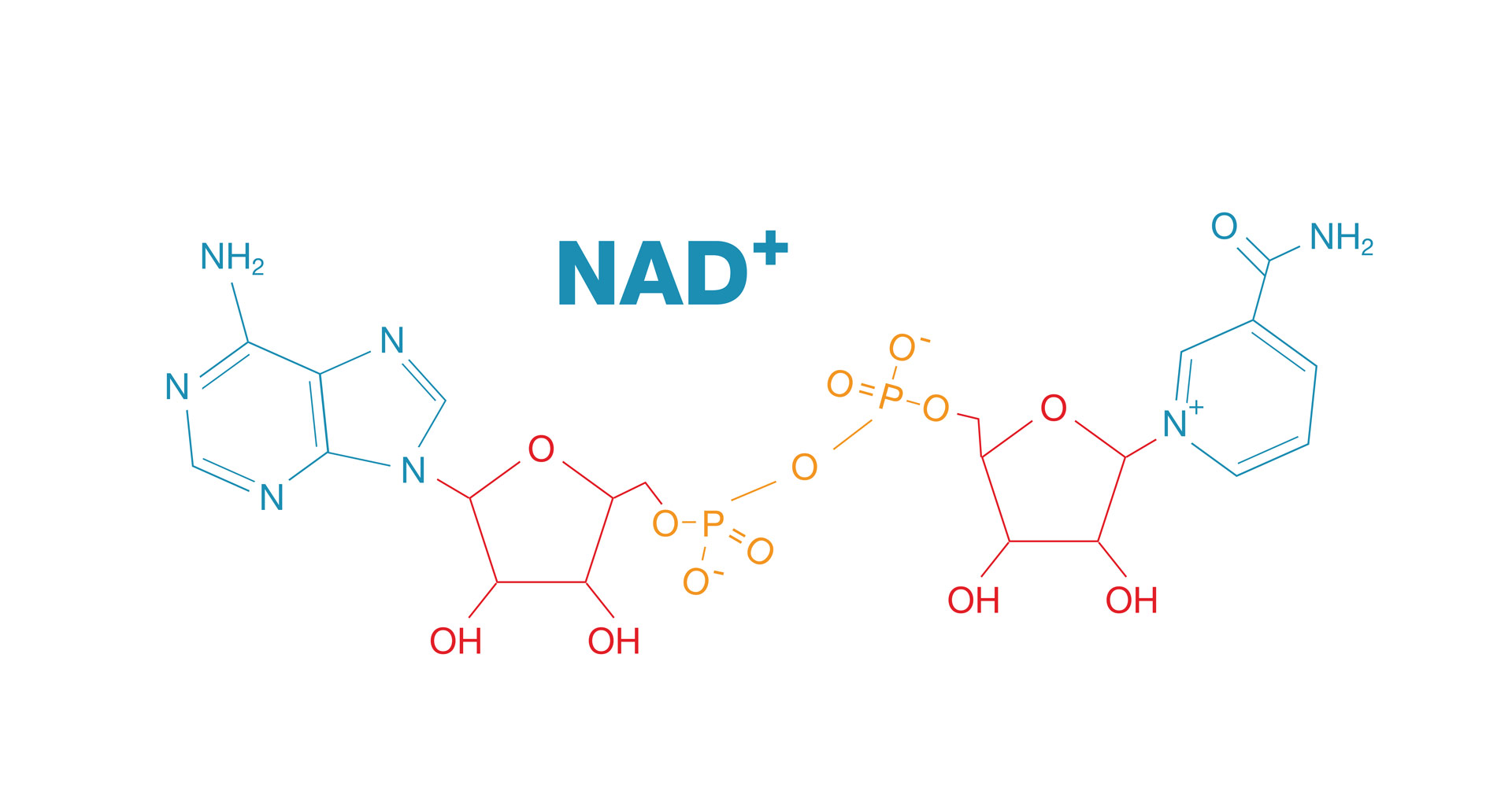
NAD stands for nicotinamide adenine dinucleotide. From bacteria to primates, it is one of the most abundant and crucial molecules in cellular metabolism. In fact, without the presence of NAD+, we would probably die in 30 seconds. The molecule is a linchpin to the function of the generators of cells — mitochondria. NAD+ not only helps convert food to energy, but it also plays a crucial role in maintaining DNA integrity. NAD+ ensures the functioning of our defensive genes to help the body and protects us from aging and disease.

NAD+ works as a shuttle bus, transferring electrons across one cellular molecule to another. With its molecular counterpart, NADH, it participates in various metabolic reactions with electron exchange. Such metabolic reactions generate adenosine triphosphate (ATP), the “energy” molecule for the body. Without sufficient NAD+ levels, inhibition of ATP production may occur.
Other functions of NAD+ include regulating the sleep/wake cycle. NAD+ drives sirtuins to regulate metabolism and maintain stable chromosomes. The molecule also helps with repairing damaged DNA.
NAD+ levels fall as people age, suggesting important implications in metabolic function and age-related diseases.
As people age, DNA damage accumulates. DNA damage activates the enzyme, PARP. PARP uses NAD+ to perform its DNA repair functions. PARP breaks down NAD+ in this process.
NAD+ depletion through PARP activation during aging may contribute to various diseases. In animal cellular models of diseases, such as cellular stress, PARP gets activated due to DNA damage. The research indicates NAD+ depletion in these diseases occurs primarily due to PARP activation. It also indicates the NAD+ depletion through PARP contributes to DNA damage and inflammation in diseases.
Enzymes in our immune system consume NAD+, too. The more active the immune system is the more NAD+ the enzyme consumes. The level of enzymes in our immune system increases as we age, depleting the NAD+ levels in the body.
Another class of enzymes using NAD+, sirtuins, can deplete NAD+ levels in the body with aging. Sirtuins play essential roles in maintaining chromosome stability, along with DNA repair. As DNA damage and chromosome instability accumulate with age, sirtuins consume more NAD+.
Scientists have identified some sources of NAD+ depletion with age that include: deficiencies in the NAD+ biosynthesis cellular process, PARP consumption of NAD+, immune system enzymes consuming NAD+, and sirtuin usage of NAD+. Currently, scientists believe of these sources of NAD+ depletion, PARPs contribute the most.

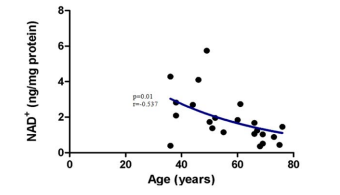
Reductions in NAD+ as males age (left). Line “a” represents a fitted curve over the lifetime. Line “b” represents a post-pubescent fitted curve. Reductions in NAD+ levels as post-pubescent females age (right).
When cells make NAD+ in the body, scientists call the process “biosynthesis.” Two cellular pathways in cells provide NAD+ biosynthesis: the de novo pathway and the salvage pathway.
The de novo pathway starts an essential amino acid, called tryptophan. Tryptophan comes from food sources like meat, cheese, eggs, and fish. The conversion of tryptophan to NAD+ happens in the aqueous part of cells, called cytosol, which is outside of the cellular components, organelles.
The salvage pathway of NAD+ biosynthesis uses naturally-occurring vitamins. These vitamins include nicotinamide, nicotinic acid, nicotinamide mononucleotide (NMN), and nicotinamide riboside (NR),
Nicotinic acid converts to NAD+ through three steps. In the first step, the enzyme NAPRT converts nicotinic acid to nicotinic acid mononucleotide (NAMN). In the second step, the enzyme, NMNAT, converts NAMN to nicotinic acid adenine dinucleotide (NAAD). The enzyme, NAD+ synthetase (NADS) then converts NAAD to NAD+.
NAD+ biosynthesis in the salvage pathway involves nicotinamide’s conversion to NMN via an enzyme, phosphoribosyltransferase, NMNAT. The enzyme converts NMN to NAD+.
NR converts to NMN with the action of an enzyme, NRK. NMN transforms into NAD+ through the enzymatic activity of NMNAT.
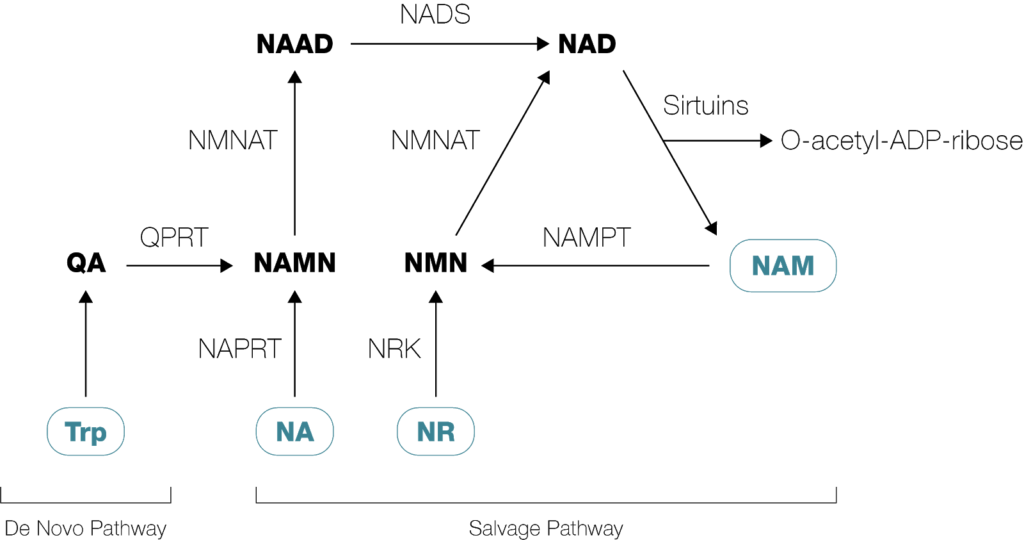
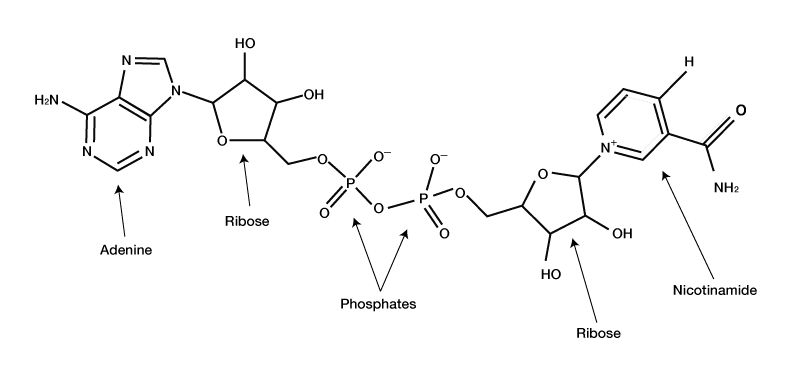
NAD+ is made of two nucleotides joined through phosphate groups. One nucleotide contains an adenine nucleobase and the other a nicotinamide.

Braidy et al. (2019). Chemical structures of NAD+ precursors
NAD+ precursor supplementation represents a potential therapeutic strategy to slow aging and improving conditions of age-related diseases. Oral supplementation with NAD+ has not been demonstrated to show any benefits in increasing NAD+ levels in the body. However, supplementation with precursors, such as NMN or NR, likely provides these benefits.
Studies indicate NMN supplementation protects against various diseases. This effect probably arises through increasing NAD+ levels in the body. NMN supplementation reduces obesity and protects blood vessels from damage in mice. The benefits come in mouse disease models of Alzheimer’s disease, cognitive impairment, and neuroinflammation as well. Supplementation of mice with NR also has similar beneficial effects.
Could these beneficial effects in mice apply to humans? Only clinical trials performed in humans will tell.
Which precursor supplement promotes higher levels of NAD+ in the body during aging, NMN or NR? The debate between scientists continues.
NAD+ is a cofactor and a coenzyme. A cofactor is a non-protein compound required for an enzyme’s abilities to speed up reactions. Cofactors are “helper molecules,” assisting in biochemical transformations.
NAD+ functions as a cofactor in electron transfer reactions of metabolism. However, NAD+ acts as a coenzyme when binding to proteins called sirtuins. The molecule binds to these proteins which later release them for further use.
Numerous studies demonstrate reduced NAD+ levels in disturbed nutrient conditions, such as obesity, and aging. Reductions in NAD+ levels can lead to problems with metabolism. These problems can lead to disorders, including obesity and insulin resistance. Obesity causes diabetes and high blood pressure.
Metabolic disorders caused by the low NAD+ level cascade down. High blood pressure and other heart function decline can send damaging pressure waves to the brain that may lead to cognitive impairment.
Targeting NAD+ metabolism is a practical nutritional intervention in protecting against metabolic and other age-related diseases. Several groups have done studies indicating supplementing with NAD+ boosters improves insulin resistance from obesity. In mouse models of age-related diseases, supplementing with NAD+ boosters improves symptoms of the diseases. This suggests reduced NAD+ levels with age may contribute to the onset of age-related diseases.
Preventing the decline of NAD+ offers a promising strategy to combat metabolism disorders with age. As NAD+ levels decrease with age, this can lead to reduced DNA repair, cellular stress response, and regulation of energy metabolism.
NAD+ is important for species’ mitochondrial maintenance and gene regulation regarding aging. However, the level of NAD+ in our body declines drastically with age. “As we get older, we lose NAD+. By the time you’re 50, you have about half the level you once had when you were 20,” says David Sinclair of Harvard University in an interview.
Studies have shown the decrease of the molecule associates with age-related diseases including accelerated aging, metabolic disorders, heart disease, and neurodegeneration. Low levels of NAD+ is associated with age-related disease due to less functional metabolism. But replenishing NAD+ levels has presented anti-aging effects in animal models, showing promising results in reversing age-related diseases, increasing lifespan and healthspan.
Known as the “guardians of genomes,” sirtuins are genes that protect organisms, from plants to mammals, against deterioration and diseases. When the genes sense the body is under physical stress, such as exercising or hunger, it sends out troops to defend the body. Sirtuins sustain genome integrity, promote DNA repair and have shown anti-aging related properties in model animals like increasing lifespan.
NAD+ is the fuel that drives the genes to work. But like a car cannot drive without its fuel, sirtuins require NAD+. Results from studies show that raising NAD+ level in the body activates sirtuins and increases lifespan in yeast, worms, and mice. Although NAD+ replenishing shows promising results in animal models, scientists are still studying how these results can translate to humans.
As the powerhouse of the body, mitochondrial function is crucial for our exercise performance. NAD+ is one of the keys to maintaining healthy mitochondria and steady energy output.
Increasing NAD+ levels in muscle can improve its mitochondria and fitness in mice. Other studies also show that mice that take NAD+ boosters are leaner and can run farther on the treadmill, showing a higher exercise capacity. Aged animals that have a higher level of NAD+ outperforms its peers.
Declared as an epidemic by the World Health Organization (WHO), obesity is one of the most common diseases in modern society. Obesity can lead to other metabolic disorders such as diabetes, which killed 1.6 million people around the globe in 2016.
Aging and high-fat diet reduce the level of NAD+ in the body. Studies have shown that taking NAD+ boosters can alleviate diet-associated and age-associated weight gain in mice and improve their exercise capacity, even in aged mice. Other studies even reversed the diabetes effect in female mice, showing new strategies to fight metabolic disorders.
The elasticity of the arteries acts as a buffer between pressure waves sent out by heartbeats. But arteries stiffen as we age, contributing to high blood pressure, the most important risk factors for cardiovascular disease. One person dies from cardiovascular disease every 37 seconds in the United States alone, CDC reports.
High blood pressure can cause an enlarged heart and blocked arteries that lead to strokes. Boosting NAD+ levels gives protection to the heart, improving cardiac functions. In mice, NAD+ boosters have replenished NAD+ levels in the heart to baseline levels and prevented injuries to the heart caused by a lack of blood flow. Other studies have shown that NAD+ boosters can protect mice from abnormal heart enlargement.
By 2050, the world’s population aged 60 and older is projected to total 2 billion, nearly double the number of 2015, according to WHO. People worldwide are living longer. However, aging is the main risk factor for many neurodegenerative diseases including Parkinson’s disease and Alzheimer’s, causing cognitive impairment.
In mice with Alzheimer’s, raising the NAD+ level can decrease protein build up that disrupts cell communication and increases cognitive function. Boosting NAD+ levels also protects brain cells from dying when there’s insufficient blood flow to the brain. Many studies in animal models present new prospects of helping the brain age healthy and defend against neurodegeneration.
Yes, it does. If you were a mouse. Increasing NAD+ with boosters, such as NMN and NR, can extend lifespan and healthspan in mice.
Increased NAD+ levels give a modest effect with extending lifespan in mice. Using the NAD+ precursor, NR, scientists find in a study published in Science, 2016, NR supplementation increases mice’s lifespan by roughly five percent.
Boosted NAD+ levels also confer protection against various age-related diseases. Protection against age-related diseases means living a healthier life for a longer period, increasing healthspan.
In fact, some anti-aging scientists like Sinclair consider the results in the animal study successful that they, themselves, are taking NAD+ boosters. However, other scientists like Felipe Sierra of the national institute on aging at NIH don’t think the drug is ready. “The bottom line is I don’t try any of these things. Why don’t I? Because I’m not a mouse,” he said.
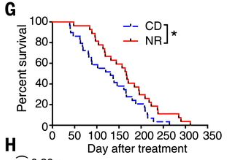
Zhang et al. (2016)
To mice, the search of the “fountain of youth” might have come to an end. However, for humans, scientists agree that we are not quite there yet. Clinical trials of NMN and NR in humans may provide results in the next few years.
NAD+ levels can be increased by promoting its synthesis — enhancing the enzymes involved in NAD+ biosynthesis or taking NAD+ precursor molecules.
Leading a healthy lifestyle through a healthy diet and moderate exercise is not only good for your mental health, but it can also boost your NAD+ levels.
Mild physical stress to the body such as fasting and exercise can stimulate the production of NAD+. In yeast, calorie restriction activates NAD+ dependent genes, sirtuins, and extends their lifespan substantially. Calorie restriction also consistently improved healthspan across different mice strains and sexes.
Many animal studies show that animals can also boost their NAD+ level through exercise. A recent study in humans finds that aerobic and resistance exercise can restore age-dependent enzymes involved in NAD+ synthesis in muscles.
People use NMN and NR as supplements to boost NAD+ levels. NMN and NR are biosynthesis precursors of NAD+. Similarities between these precursors include their usage of the “salvage pathway” of NAD+ biosynthesis. The two molecules are both safe for human consumption, too.
Scientists have conducted studies in humans demonstrating NR can boost NAD+ levels. Studies on NMN also show its ability to boost NAD+ levels in rodents.
A study indicates mice have an NMN transporter in their gut. The gene for the same transporter is present in humans. If the NMN transporter has a similar expression in humans, the body may utilize NMN.
People take NAD+ supplements for a variety of reasons, including enhancement in sports performance, a younger complexion and to fight age-associated diseases. Although some claim that the boosters made them feel young and energetic, others don’t see the same results.
Mounting evidence from animal studies may have fueled the hype on these therapeutic claims. NAD+ supplementation raises the bioavailability of NAD+ in cells, reversing age-related disease and modestly increasing lifespans in animal models. However, the question remains whether these findings from animal models translate to humans. Currently, no clinical trial has found evidence that the supplements have therapeutic properties in humans.
For many, the aging of the world’s population can mean spending more time with loved ones, but it also comes with a burden of living with age-associated chronic diseases. In 2016, the nation’s health care treatment for chronic diseases totaled $1.1 trillion, according to the Milken Institute. Combined with the lost economic productivity, the total economic impact was 3.7 trillion — nearly 20 percent of the U.S. gross domestic product.
As the “silver wave” rolls in, a solution for age-associated chronic diseases to lift the health and economic burden becomes urgent. Scientists may have found a possible solution: NAD+.
Dubbed the “miracle molecule” for the capability to restore and maintain cellular health, NAD+ has shown various potentials in treating heart diseases, diabetes, Alzheimer’s, and obesity in animal models. However, understanding how studies in animals can translate to humans is the next step for scientists to ensure the safety and efficacy of the molecule.
Scientists aim to fully understand the biochemical mechanism of the molecule and the research on NAD+ metabolism continues. The details of the molecule’s mechanism may unveil the secret to bringing anti-aging science from bench to bedside.